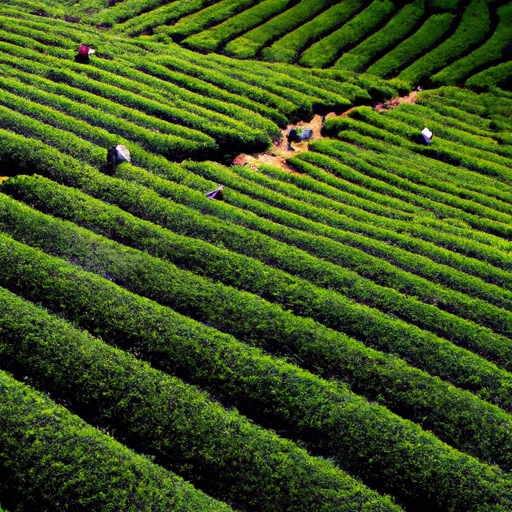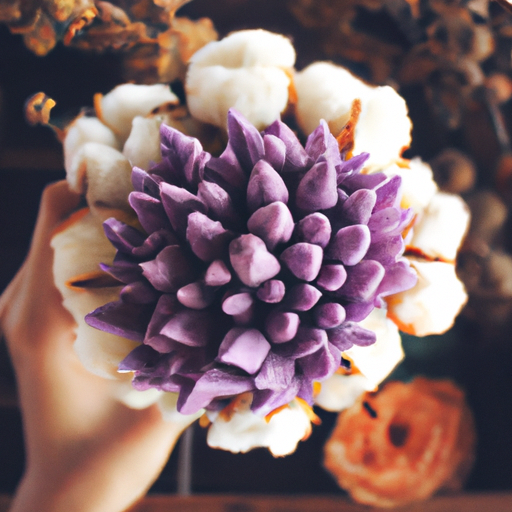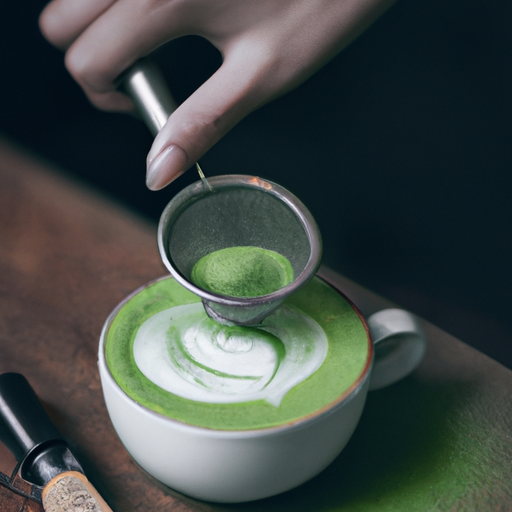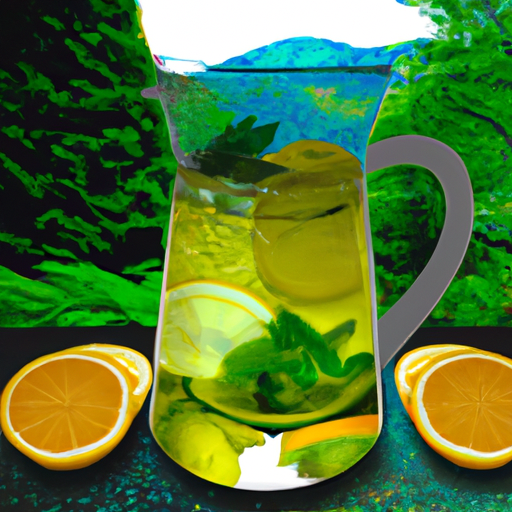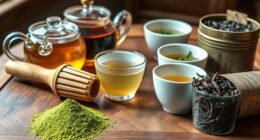As someone who deeply appreciates tea, I’ve always been captivated by the history behind my most cherished teas. Recently, Matcha has become increasingly popular. This tea, a finely milled powder produced from green tea leaves grown specifically for this purpose, has long been central to tea ceremonies in Japan. However, it has recently gained a global following, becoming a fashionable beverage worldwide.
In this article, I will be exploring the question of where Matcha is grown and all the factors that contribute to its unique taste and quality.
Matcha is a premium tea that requires specific growing conditions and careful cultivation. It is grown primarily in Japan, where the tea masters have perfected the art of Matcha production. However, not all regions in Japan are suitable for growing Matcha. The tea plants require shade, ideal soil conditions, and a specific microclimate to thrive.
In the following sections, I will be exploring the different regions of Japan where Matcha is grown, the ideal growing conditions for Matcha tea, and the impact of these factors on the flavor and quality of the tea.
Key Takeaways
- Matcha is primarily grown in Japan, where tea masters have perfected the art of Matcha production.
- The three famous regions in Japan for matcha production are Uji, Nishio, and Shizuoka.
- Ideal growing conditions for matcha tea include a temperate climate, fertile soil, and ample rainfall, which are found in these regions.
- To ensure the highest quality matcha, the tea plants are grown in the shade for several weeks before harvesting, and only the youngest and most tender leaves are picked.
The History of Matcha Tea
So, you’re probably wondering why matcha tea has been such an important part of Japan’s culture for centuries.
Well, the history of matcha tea dates back to the Tang Dynasty in China, where it was consumed by Buddhist monks to aid in meditation. It was then brought to Japan in the 12th century by Zen master Eisai, who believed that matcha tea had many health benefits and could help with focus and concentration.
Over time, matcha tea became more than just a drink for meditation and health benefits. It became a symbol of Japanese culture and hospitality, often served during traditional tea ceremonies. Consumption patterns also changed, with matcha being used in desserts, snacks, and even savory dishes.
Today, matcha tea is still an integral part of Japanese culture and is enjoyed all over the world.
But where exactly does matcha come from in Japan? Let’s explore the different regions where matcha is grown and how each region’s climate and soil affect the taste and quality of the tea.
The Different Regions of Japan Where Matcha is Grown
Matcha lovers can explore the unique flavors and aromas of Uji, Nishio, and Shizuoka, the three famous regions in Japan where this vibrant green tea is produced.
Uji, located in Kyoto, is considered the birthplace of matcha and has been producing top-quality tea for over 800 years. Nishio, located in Aichi Prefecture, is known for its matcha that has a rich and savory flavor. Shizuoka, located in the central part of Japan, is famous for producing matcha with a delicate sweetness and smooth texture.
Matcha cultivation techniques vary in each of these regions, but all three are committed to sustainable matcha farming practices. The farmers in Uji, for example, use a traditional shading method known as tana, which involves covering the tea plants with bamboo screens to protect them from direct sunlight. This technique encourages the plants to produce more chlorophyll and amino acids, resulting in a sweeter and smoother taste.
In Nishio, farmers use a unique technique called yoshidashime, which involves covering the tea plants with straw mats instead of bamboo screens. This method produces matcha with a distinct umami taste. Ideal growing conditions for matcha tea include a temperate climate, fertile soil, and ample rainfall.
The regions of Uji, Nishio, and Shizuoka are known for having these ideal conditions, which is why they are the top producers of matcha in Japan. The quality of matcha tea also depends on the timing of the harvest, with the first flush being the most prized.
In the next section, we will explore the ideal growing conditions and harvest techniques used to produce the highest quality matcha.
Ideal Growing Conditions for Matcha Tea
The lush green tea plants thrive in temperate climates with fertile soil and regular rainfall, creating the ideal growing conditions for high-quality matcha tea. The perfect climate for matcha cultivation is a moderate temperature of around 20°C with a consistent amount of rainfall.
The soil quality is also essential in growing the tea plant. The soil should be rich in nutrients, acidic, and well-drained to provide the necessary nutrients for the plant to grow. In Japan, matcha is primarily grown in the regions of Uji, Nishio, Shizuoka, and Kyushu, where the climate and soil conditions are ideal.
The Uji region, located in Kyoto, is known to produce the highest quality matcha due to its nutrient-rich soil, abundant rainfall, and unique microclimate. Shizuoka, on the other hand, has a milder climate, making it easier to cultivate matcha throughout the year.
To ensure the highest quality matcha, the tea plants are grown in the shade for several weeks before harvesting. This process enhances the chlorophyll and amino acid content, resulting in a darker green color and a sweeter, more umami flavor. Harvesting is done by hand, and only the youngest and most tender leaves are picked. These leaves are then steamed, dried, and ground into a fine powder, which is then used to make matcha tea.
The Matcha Growing Process
You might be surprised to learn that the process of growing high-quality matcha tea involves carefully cultivating tea plants in ideal conditions and using a unique shading technique to enhance the flavor and color of the leaves. Matcha cultivation techniques have been perfected over centuries by Japanese tea farmers, who have learned how to optimize every aspect of the growing process to produce the finest quality tea.
Environmental factors play a crucial role in matcha cultivation, as the tea plants require specific conditions to thrive. Matcha is typically grown in mountainous regions with fertile soil, ample rainfall, and mild temperatures. Farmers carefully monitor the conditions and adjust their growing techniques accordingly to ensure that the tea plants receive the optimal amount of sunlight, water, and nutrients.
To maximize the flavor and color of the tea leaves, farmers use a shading technique that involves covering the tea plants with bamboo or straw mats for several weeks before harvesting. This reduces the amount of sunlight that reaches the leaves, which causes them to produce more chlorophyll and amino acids, resulting in a richer, sweeter taste and a vibrant green color. This method is one of the key factors that sets matcha apart from other types of tea.
The impact of growing conditions on the taste and quality of matcha tea is significant, and every step of the process is carefully monitored to ensure that the final product meets the highest standards. By using traditional cultivation techniques and paying close attention to environmental factors, Japanese tea farmers have been able to produce matcha tea that is renowned for its exceptional flavor and health benefits.
The Impact of Growing Conditions on the Taste and Quality of Matcha Tea
Growing high-quality matcha tea is like nurturing a delicate flower. It requires specific environmental conditions and careful cultivation techniques to produce a rich, sweet flavor and vibrant green color. The climate impact on matcha tea is fundamental. It thrives in regions with moderate temperatures and high humidity. The tea plant requires a stable environment with plenty of rainfall, as it prefers moist, well-drained soils that are rich in nutrients. Matcha tea is mainly grown in Japan, where the climate is ideal for its cultivation.
The soil quality is another crucial factor that affects the taste and quality of matcha tea. The tea plant requires fertile, well-drained soils that are rich in organic matter. The cultivation of matcha tea involves enriching the soil with natural fertilizers, such as compost and green manure, to maintain its fertility. The plants are also pruned regularly to ensure optimal growth and yield. The soil quality, combined with careful cultivation techniques, is what gives matcha tea its distinct flavor and aroma.
The climate impact and soil quality are critical factors that affect the taste and quality of matcha tea. The tea plant thrives in regions with moderate temperatures and high humidity, and it requires fertile, well-drained soils that are rich in nutrients. Matcha tea is mainly grown in Japan, where the climate and soil conditions are ideal for its cultivation.
The next step is to understand the different grades of matcha tea and how they differ in taste and quality.
The Different Grades of Matcha Tea
To truly appreciate the subtle nuances of each variety, it’s essential to understand the different grades of this finely ground green tea. The quality and taste of matcha tea are determined by the growing conditions and the harvesting process.
The highest quality matcha tea comes from the first harvest, which takes place in early spring. The leaves used to create matcha tea are shaded for several weeks before the harvest, which reduces the amount of sunlight and increases the production of chlorophyll and amino acids. This gives the tea a distinct sweet and umami flavor that sets it apart from other green teas.
Matcha grades are categorized based on their quality and taste comparison. The highest quality matcha tea is called ceremonial grade, which is made from the youngest tea leaves and is hand-picked. It has a bright green color and a smooth, creamy texture.
The next grade is premium grade, which is made from slightly older tea leaves and is machine-harvested. It has a slightly bitter taste and is less vibrant than ceremonial grade.
The lowest grade is culinary grade, which is made from the oldest tea leaves and is often used in cooking. It has a stronger, more bitter taste and is less vibrant in color.
To prepare matcha tea, it’s important to choose the right grade based on your personal preference. Ceremonial grade is best enjoyed on its own, while premium and culinary grades are better suited for lattes or other recipes.
The preparation process involves whisking the tea with hot water until it becomes frothy. This helps to release the full flavor and aroma of the tea. When done correctly, matcha tea can be a delicious and healthy addition to your daily routine.
Now that you understand the different grades of matcha tea, let’s move on to the next step: how to prepare matcha tea.
How to Prepare Matcha Tea
If you’re looking for a delicious and healthy pick-me-up, preparing a frothy cup of matcha tea is a great option. Not only is it a great source of antioxidants, but it also contains caffeine and L-theanine, which work together to provide a calm and focused energy boost.
Matcha tea has been a staple in Japanese culture for centuries, and it’s no wonder why it’s gaining popularity worldwide. To prepare matcha tea, you’ll need a few tools and ingredients. First, you’ll need a bamboo whisk (chasen) and a small ceramic bowl (chawan). Next, sift 1-2 teaspoons of matcha powder into the bowl. Then, add hot (but not boiling) water and whisk vigorously in a zig-zag motion until a frothy layer forms on top. Finally, enjoy your delicious and healthy cup of matcha tea.
It’s important to note that there is also a traditional matcha tea ceremony etiquette, which involves certain gestures and movements. While it may seem intimidating at first, participating in a matcha tea ceremony can be a unique and enjoyable experience. However, if you’re just preparing matcha tea for yourself at home, there’s no need to worry about following all the traditional rules. Simply enjoy the health benefits and delicious taste of this ancient beverage.
Transitioning into the subsequent section about popular matcha tea recipes, there are many ways to incorporate matcha tea into your daily routine. From adding it to smoothies and lattes to baking with it, the possibilities are endless. Let’s explore some creative and tasty ways to enjoy matcha tea.
Popular Matcha Tea Recipes
You’ll love incorporating this healthy green powder into your daily routine with these popular and delicious matcha tea recipes. Matcha is a versatile ingredient that can be used in a variety of drinks and dishes.
One of the most popular ways to enjoy matcha is by making a matcha latte. To make a matcha latte, simply whisk together some matcha powder, hot water, and your choice of milk. You can add sweetener if desired, but matcha has a natural sweetness that pairs well with a creamy milk.
Another tasty way to incorporate matcha into your diet is by making a matcha smoothie. To make a matcha smoothie, blend together some matcha powder, frozen banana, spinach, almond milk, and honey. This drink is packed with nutrients and is a great way to start your day. You can also experiment with different ingredients to customize your matcha smoothie to your taste.
Incorporating matcha into your diet is a great way to reap its health benefits. Matcha is rich in antioxidants, helps with concentration, and boosts metabolism. Drinking matcha regularly can also improve your overall mood and help you feel more energized throughout the day. So why not try out these delicious matcha tea recipes and start enjoying all the benefits that this superfood has to offer?
Moving on to the subsequent section about the health benefits of matcha tea, it’s important to note that matcha is a powerhouse when it comes to nutrition. Its high concentration of antioxidants and catechins can help reduce inflammation, lower cholesterol levels, and even prevent certain types of cancer. So not only are these matcha tea recipes delicious, but they’re also a great way to boost your overall health and wellbeing.
Health Benefits of Matcha Tea
As I sip on a warm cup of matcha tea, I can’t help but appreciate the numerous health benefits it provides. Matcha production involves growing and harvesting young tea leaves, which are then ground into a fine powder. This process ensures that all the nutrients and antioxidants present in the tea leaves are preserved, making matcha tea one of the healthiest drinks available.
Matcha tea is loaded with antioxidants that help fight off free radicals in the body. These free radicals are unstable molecules that can cause cellular damage and lead to chronic diseases such as cancer, heart disease, and Alzheimer’s. Matcha tea contains a unique antioxidant called EGCG (epigallocatechin gallate), which is known to have powerful anti-inflammatory properties and may help lower the risk of these diseases.
In addition to its antioxidant properties, matcha tea is also known to boost metabolism and promote weight loss. Studies have shown that drinking matcha tea can increase calorie burning by up to 17%, making it an excellent addition to any weight loss program.
So, if you’re looking for a delicious and healthy beverage that can provide you with numerous benefits, matcha tea is definitely worth a try!
Frequently Asked Questions
What is the difference between matcha tea and other types of green tea?
As someone who loves tea, I can confidently say that matcha tea is in a league of its own.
The main difference between matcha tea and other types of green tea lies in the way it’s grown, harvested, and processed.
Matcha tea is grown in shaded fields, which slows down the growth of the tea leaves and increases the chlorophyll content. This gives matcha tea its characteristic vibrant green color and unique flavor profile.
Unlike other types of green tea, matcha tea is ground into a fine powder, which means that you’re consuming the whole tea leaf and all of its nutrients. This makes matcha tea one of the healthiest beverages you can consume, as it’s packed with antioxidants, vitamins, and minerals.
Some of the benefits of drinking matcha tea include boosting your energy levels, improving your mental clarity and focus, and aiding in weight loss.
Additionally, matcha tea is incredibly versatile and can be used in a variety of recipes, from smoothies and lattes to baked goods and savory dishes.
Whether you’re looking to improve your health or simply enjoy a delicious cup of tea, matcha tea is definitely worth trying.
How long has matcha tea been consumed in Japan?
Matcha tea has a rich history in Japan, dating back to the 12th century. It has been an integral part of Japanese culture and is often used in traditional tea ceremonies.
The health benefits of matcha tea have been known for centuries, with studies showing that it contains high levels of antioxidants and can help improve mental focus and energy levels. In addition, matcha tea is known to boost metabolism and support weight loss.
While it is now enjoyed all over the world, matcha tea remains a beloved part of Japanese culture and tradition.
What are the environmental impacts of matcha tea cultivation?
Sustainable farming practices are crucial to minimizing the environmental impacts of matcha tea cultivation. The use of fertilizers and pesticides can lead to soil erosion and contamination of nearby water sources, so it’s important to use natural and organic methods of pest control and soil management.
Additionally, matcha tea is typically grown in shaded environments, which can have a negative impact on the surrounding ecosystem if not done properly. By implementing sustainable farming practices, we can ensure that matcha tea cultivation has a minimal impact on the environment while still producing high-quality tea.
Can matcha tea be grown outside of Japan?
Growing matcha tea outside of Japan is possible, but it requires a lot of effort and skill. It’s like swimming against the current, but it isn’t impossible.
To cultivate matcha outside of Japan, you need to have a deep understanding of the traditional matcha cultivation techniques used in Japan. Since matcha’s cultural significance outside of Japan has been growing rapidly in recent years, many farmers around the world have started experimenting with growing matcha tea.
However, it’s not just about growing the tea leaves; it’s about understanding the entire process of matcha production, and how each step affects the final product’s quality. The tea leaves need to be grown in an environment that mimics the traditional Japanese climate, and the processing of the leaves needs to be done with the same precision and care as in Japan.
In short, growing matcha outside of Japan requires dedication, patience, and a deep understanding of the art and science of matcha cultivation.
How much matcha tea is typically produced per harvest season?
In terms of matcha production, the yield per harvest season varies depending on several factors such as weather conditions, soil quality, and farming techniques. On average, a single harvest season can produce anywhere from 20 to 30 tons of matcha tea. However, some high-quality matcha farms may only produce a few kilograms per season due to their meticulous cultivation and harvesting processes.
Ultimately, the matcha yield per harvest season is subject to the many variables that come with growing this delicate tea, making it a highly sought after and prized commodity.
Conclusion
Well, folks, that’s all for now. I hope you’ve learned a lot about where matcha is grown, the ideal growing conditions, and the different grades of matcha tea.
While matcha has been around for centuries, it has only recently gained popularity in the Western world. However, it’s quickly become a favorite among health enthusiasts and tea lovers alike.
One thing to keep in mind is that the taste and quality of matcha tea is greatly influenced by the growing conditions. Therefore, it’s important to know where your matcha comes from and how it was grown.
Next time you sip on a cup of matcha tea, think about the journey it took from the tea fields to your teacup. And who knows, maybe you’ll even appreciate it a little more!

